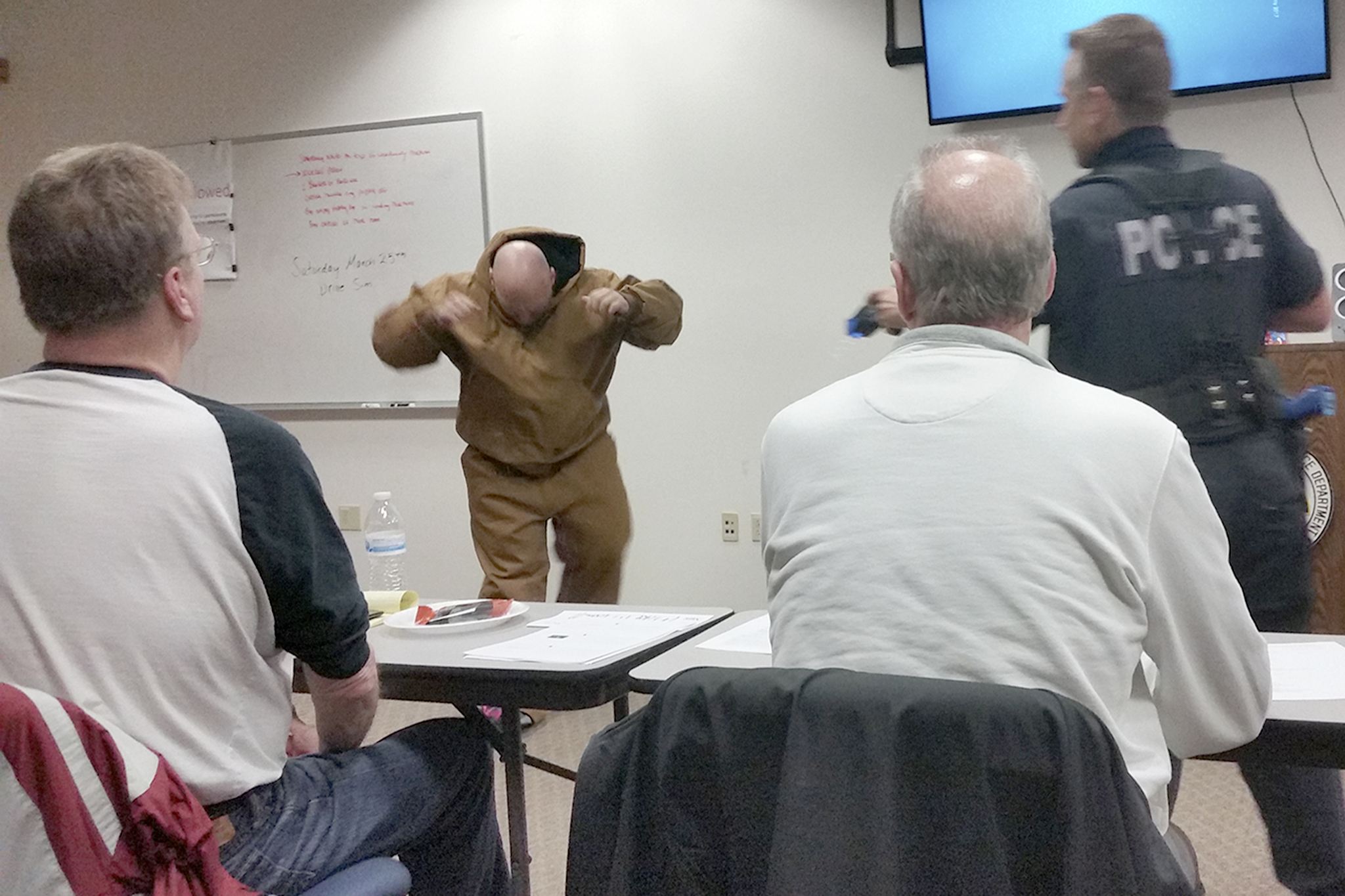Second in a series
By Steve Powell
spowell@marysvilleglobe.com
MARYSVILLE – A man in an oversized brown coat walked into the room and started yelling profanities at a policeman.
When the man lunged toward the officer, he responded by shooting him with a stun gun. As the man stumbled and fell, he pulled out a pistol. The officer responded by shooting him.
That scenario played out at the second Marysville Police Citizen’s Academy class Feb. 9.
Participants were asked if the perp’s gun was on his left or right side. None of us knew. We assumed right since he was right handed. But as a potential witness to a crime you can’t assume. It actually had been in his left inside pocket.
It happened so fast I didn’t even notice it, but the officer had yelled out, “He’s got a gun,” before shooting. “Witnesses hear that,” Officer Stacey Dreyer said. “He’s building his case right out of the gate.”
The officers said that a key to staying alive is not to get complacent. That can be hard to do since they deal with many of the same culprits time after time. It can become routine.
But that can be deadly, Cmdr. Mark Thomas said.
He told the story of Officer William “Don” Arndt, the only Marysville policeman ever killed in the line of duty. Arndt answered a call on a young man threatening suicide. The boy had a history of mental illness, and Arnett had dealt with him many times before. The boy’s parents said he was up in his room with a gun. Arndt was killed trying to help the boy.
The officers also answered questions about the the previous week’s scenarios. One question dealt with why the officers worked in pairs.
“It’s the only way to cover his back,” Thomas said. “He doesn’t have to guess where I’m at.”
They were also asked why they kept looking for other perps when there was no evidence any were there.
“We don’t want to be caught by surprise. In my mind I’m always looking for more,” Dreyer said.
He added the same thing with guns. “When there’s one there’s two,” he said.
Participants also wondered why the officer touched the vehicle as he approached the suspect’s car. It’s because the officer’s fingerprints are now on the car so it can be identified later if need be.
Students also wondered why a shot suspect was made to crawl to police.
“I’m not going to put myself at risk to help a bad guy,” Dreyer said.
Later, Officer Kelly Pitts talked about Patrol Procedures, mentioning the extensive testing and training each officer gets. “They don’t just hire anyone,” Pitts said.
He explained the Police Academy is 720 hours of intense training over 4 1/2 months. He couldn’t believe how much writing he had to do. “There’s so much documentation,” he said.
Once out of the academy, the newbie works with a field training officer for almost another year.
“We put out a lot of time and money” on each officer, Pitts said, adding that’s why background checks are so important; they want people who will stick with it.
He explained when police calls come in dispatchers prioritize them. Crimes in progress have priority, along with crimes against people, compared with property.
Pitts said saving lives is the priority, with hostages first, witnesses second, fellow officers third and the suspect last. He said police adhere to abnormal behavior. “We seek out risks,” he said, adding they head toward danger while others go the other way.
Pitts talked about types of calls. On the list was fireworks, which surprised some. “It’s a big topic this year,” Pitts said. “Fireworks are illegal in Marysville. It’s going to be an uphill battle for us. We’re next to one of the largest distributors of fireworks, probably on the West Coast.”
He ended by saying being “politically correct” by carrying a handgun is not in the best interest of the officer or the public. “I’d rather carry a rifle. It’s safer and more accurate. But the U.S. is offended by the ‘military look,’” he said.
Officer Dan Ozment talked about criminal law, “the meat and potatoes of what we do.” Police determine if there is a crime through reasonable suspicion and probable cause. He talked about classes of crimes from misdemeanors to felonies, murder, rape, robbery, burglary, assault, domestic violence, mandatory arrests and more. Checking the observation skills of the class, a gun had been placed in the Don Arndt Training Room. No one saw it behind a garbage can.
“I’m going to cheat to win,” Dreyer said. “That’s why I’m still here.”


